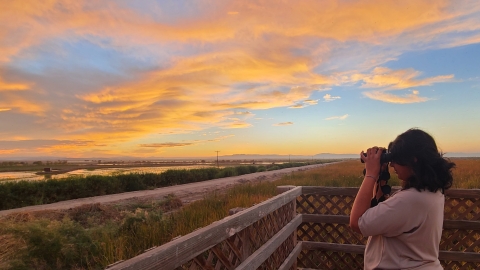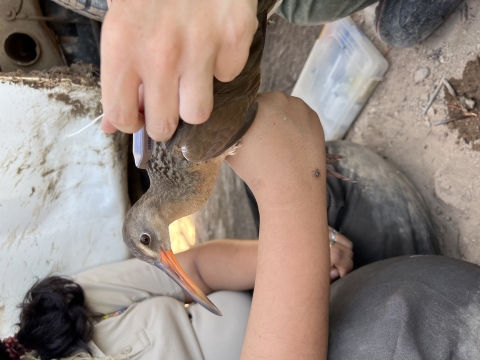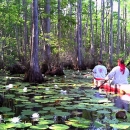What We Do
Plan and Manage Refuge Uses
A draft compatibility determination for commercial and educational recording (photography, videography, filming, and audio recording) is available for public review and comment. A compatibility determination is the process whereby the refuge manager reviews a proposed use on a refuge and determines whether the use is compatible with the purpose(s) for which the refuge was established and the National Wildlife Refuge System mission. If determined to be compatible, then the use may be permitted. Comments on the draft compatible should be submitted to fw8plancomments@fws.gov, and are due no later than February 8, 2022.
Management and Conservation
Resource Management
To help plants and wildlife, the refuge staff uses a variety of habitat management techniques to maintain, recover or enhance plant and wildlife values. Refuge staff carefully consider all accepted management techniques and current science so they can be applied in varying degrees according to the Refuge's needs.
Farming
The refuge staff partakes in an intensive farming program that produces ryegrass and wheat for over-wintering geese and sandhill cranes, while swamp timothy, watergrass, and sprangletop are cultivated in the seasonal duck ponds for a variety of water birds like ducks, sandpipers, herons, and ibis.
Wetlands
The refuge wetlands consist of seasonal duck ponds, cattail marshes, and permanent open-water wetlands. The seasonal duck ponds provide ideal habitat for shorebirds and waterfowl during the fall/winter migration period. Ponds get flooded in August and remain wet till March of the next year. While most of the seasonal duck ponds are sanctuaries about 1000 acres are open to waterfowl hunting from October to February. The cattail marshes found within the refuge are a combination of managed wetlands and wild unmanaged marshes that have developed from the agricultural drains as the Salton Sea has receded. These marshes serve as critical habitats for both the endangered Yuma Ridgeways rail and the desert pupfish. Finally, the open water wetlands are permanent year-round ponds that serve a multitude of environmental services like providing important nesting islands to the terns and skimmers that breed along the edge of the sea.
Wildlife Surveys
Refuge Biologists and partnering agencies conduct a variety of ground and aerial wildlife surveys throughout the year to monitor, inventory, and study bird population dynamics and document habitat use through the refuge and along the Salton Sea. Currently, a lot of resources are being given to different agencies to understand the extent of heavy metal contamination found in the exposed Salton Sea shoreline and what that means for the wildlife that inhabits it.
Due to its mild winter, the Refuge does not have an off-season for wildlife, summers are spent monitoring nesting birds like the Yuma Ridgeways rail and gull-billed tern while winters consist of waterfowl and wading bird surveys like the annual white-geese counts or evening sandhill crane roost surveys.
Prescribed Burns
Due to the heavy workload and ever-increasing burden of invasive plant species that inhibit the Salton Sea shoreline, the Refuge employs the use of USFWS Fire crews to perform prescribed burning on both the farm fields, seasonal duck ponds, and cattail marshes.
Disease Monitoring and Heavy Metal Contamination
For the past three decades, the refuge has worked with other agencies and organizations to address fish and wildlife diseases and contaminant issues, including the death of an estimated 150,000 eared grebes in the early 1990s, fish die-offs in 1999 and 2006, the loss of thousands of pelicans to avian botulism in 1996. While the Refuge doesn’t survey the Salton Sea for dead or dying fish and wildlife as heavily as it did in the past, passive monitoring efforts still take place and sick birds are collected and sent to our partnering agencies to test for pathogens.
Why does the Salton Sea have a disease problem?
The Salton Sea is a unique and complex ecosystem, so the answer to this question is also complex. The sea encompasses many different habitats, including saltwater, freshwater, brackish-water zones, marshes, and upland areas. In general, the water in the sea is nutrient-rich and, for much of the year, very warm. These conditions readily support the growth of harmful microbes. Millions of birds visit every year, and they can transport disease microbes here from other locations. All these factors combine to contribute to the potential for disease to occur in the Salton Sea.
Wildlife Disease: Avian Botulism
The main culprit in past bird die-offs at the Salton Sea has been avian botulism. The bacteria Clostridium botulinum is a common bacterium in wetland ecosystems, usually present in very low numbers.
Two types of botulism have been found in the Salton Sea. Type C botulism is the most common botulism strain found in wildlife. It typically affects waterfowl and poses virtually no human health risks. The second type of botulism is Type E, found largely in fish-eating birds. It is much rarer than Type C but poses greater risks to humans.
Mode of transmission
Once a few birds are infected and die, what scientists call a “carcass-maggot cycle” can begin. Flies deposit eggs on the bird carcasses, and the eggs hatch into maggots. They feed upon the carcass, a process that concentrates the toxin into the maggots’ bodies. Other birds eat the toxic maggots, then die and become food for more maggots. As the cycle accelerates, major bird die-offs occur. Due to the rapid spread of botulism through the maggot cycle, removing carcasses is critical to prevent or at least minimize the spread of the disease.
Heavy Metal Contamination
Due to the large amounts of heavy metals, like Selenium, that end up in the Salton Sea from irrigation runoff, the refuge and our partners are leading a large effort in understanding the effect of such contaminants on the local wildlife, like the endangered Yuma Ridgeway's rail. Studies are being conducted around the newly formed, wild, wetland marshes to assess the level of Selenium present in the food web, what effect it is having on the reproductive health of the rails that inhabit the marsh, and how to remove these metals from the environment.
Refuge Planning
National Wildlife Refuge planning sets the broad vision for refuge management and the goals, objectives, strategies, and actions required to achieve it. Planning ensures that each refuge meets its individual purposes, contributes to the Refuge System’s mission and priorities, is consistent with other applicable laws and policies, and enhances conservation benefits beyond refuge boundaries.
Comprehensive Conservation Plans
Comprehensive Conservation Plans (CCPs) are the primary planning documents for National Wildlife Refuges. As outlined in the National Wildlife Refuge System Administration Act, as amended, the U.S. Fish and Wildlife Service (Service) is required to develop CCPs that guide refuge management for the next 15 years. CCPs articulate the Service’s contributions to meeting refuge purposes and the National Wildlife Refuge System mission. CCPs serve as a bridge between broad, landscape-level plans developed by other agencies and stakeholders and the more detailed step-downs that stem from Refuge CCPs.
The 2014 Final Comprehensive Conservation Plan for Sonny Bono Salton Sea and Coachella Valley National Wildlife Refuges can be found here: https://ecos.fws.gov/ServCat/Reference/Profile/108501
Step-down Plans
CCP step-down plans guide refuge-level programs for (1) conserving natural resources (e.g., fish, wildlife, plants, and the ecosystems they depend on for habitat); (2) stewarding other special values of the refuge (e.g., cultural or archeological resources, wilderness, wild and scenic rivers, etc.); and (3) engaging visitors and the community in conservation, including providing opportunities for wildlife-dependent recreation. Like CCPs, step-down plans contribute to the implementation of relevant landscape plans by developing SMART (Specific, Measurable, Achievable, Relevant, and Time-bound) objectives, strategies, implementation schedules, and decision support tools to fulfill refuge visions and goals. This ensures that Refuges are managed in a landscape context and that conservation benefits extend beyond refuge boundaries.
Permitted trapping Occurs on this Refuge
Trapping is a wildlife management tool used in some National Wildlife Refuges. Trapping may be used to protect and survey endangered and threatened species or migratory birds or to control certain wildlife populations. The U.S. Fish and Wildlife Service also views trapping as a legitimate recreational and economic activity when there are harvestable surpluses of fur-bearing mammals. Outside of Alaska, refuges that permit trapping as a recreational use may require trappers to obtain a refuge special use permit. Signs are posted on refuges where trapping occurs. Recreational trapping does not occur at this Refuge.
Our Services
There are no fees to visit the refuge and refuge staff do not sell Federal Recreational Lands Passes. You can buy them online, though, from the U.S. Geological Survey's online store.





